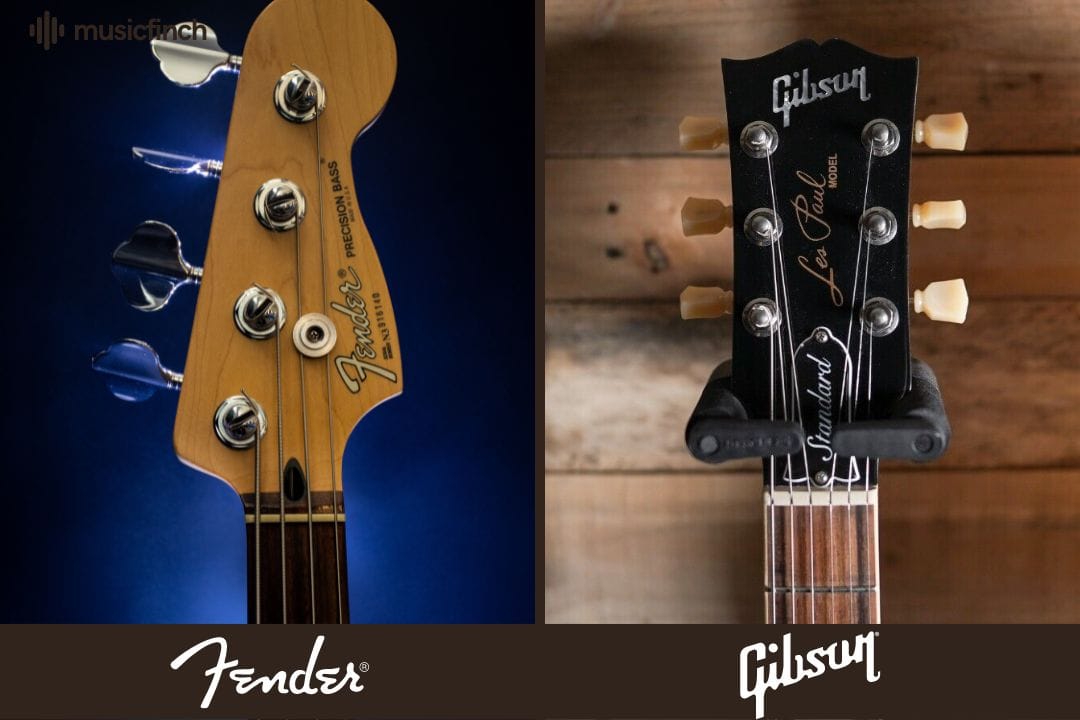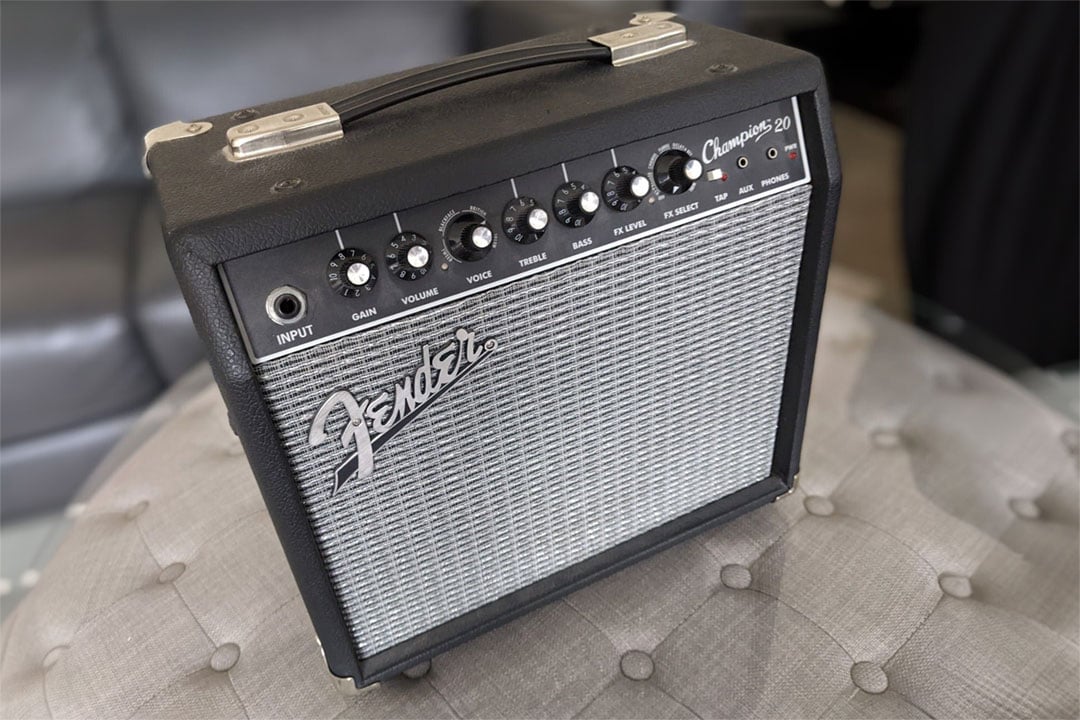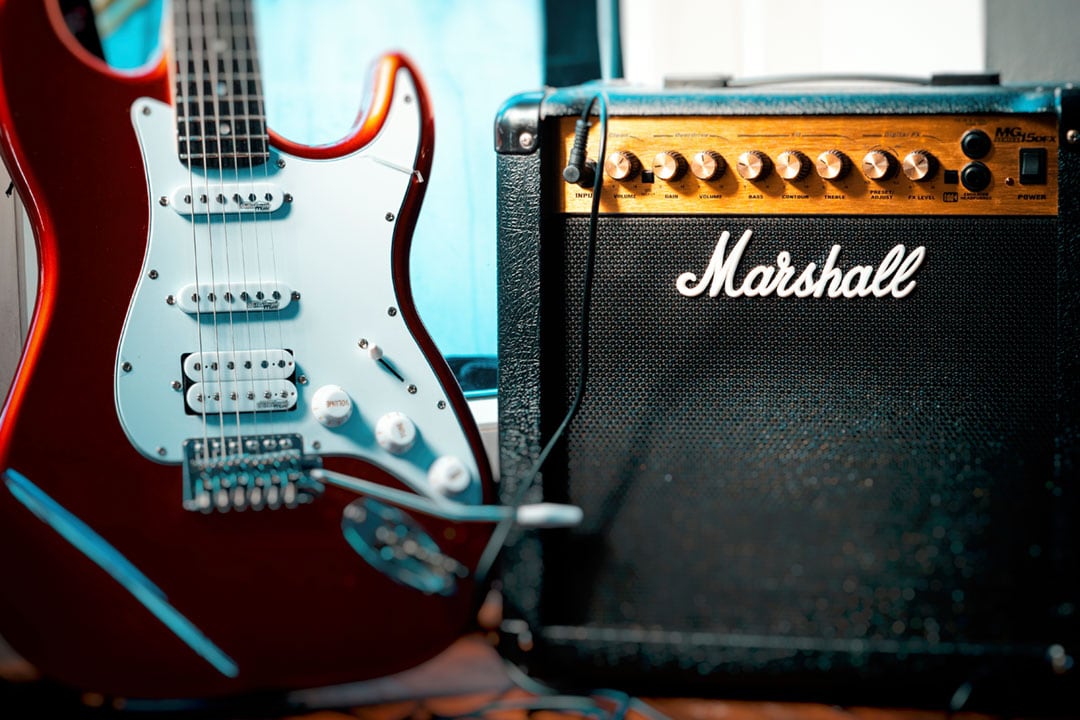Tube amplifiers may all sound the same to the untrained ear, but for the discerning audiophile, the unique signatures of top brands like Fender and Marshall shine through in the sounds they produce.
In this article, I compare Fender and Marshall tube amps, unraveling their distinct features, performance capabilities, and suitable styles.
| Fender | Marshall | |
|---|---|---|
| Historical Background | Established in the 1940s, U.S. | Established in the 1960s, U.K. |
| Tonal Characteristics | Clear, vibrant trebles and deep bass | Crunchy, rich mid-tones and warm overdrive |
| Build Quality and Design | Retro American aesthetic with forward-facing controls | Vintage British look with top-facing controls |
| Performance | Great headroom, predictable response, easy to dial in | Distortion and sustain rich, complex to dial in, offers more tonal shaping |
| Suitable Styles | Blues, jazz, country, classic rock | Hard rock, punk, metal |
Historical Background
Before we delve into the technicalities, it’s beneficial to understand the roots of these two industry heavyweights.
Notably, the cultural context from which they emerged has significantly influenced their characteristic sound.
- Fender, an American brand, was founded in the 1940s. The brand quickly became synonymous with the clean and vibrant tones of the surf rock genre in the 1960s.
- Conversely, Marshall, a British brand, was established in the 1960s. Famous for its warm and commanding ‘British Distortion‘, it soon became a staple in the toolkit of hard rock and heavy metal musicians.
Tonal Characteristics
Regarding tone—the most crucial aspect of any amplifier—both Fender and Marshall have distinctive qualities.
- Fender tube amps are celebrated for their clear, articulate, well-rounded sound, vibrant trebles, and deep bass response. On the other hand, Fender tube amps are relatively flat in the mid-tones.
- In contrast, Marshall tube amps are lauded for their crunchy, overdriven tones characterized by rich mid-tones. However, they tend to fall a little short on the high-treble spectrum.

- Versatile Tone Range: Wide range of tones, from clear, crisp cleans to heavy, distorted sounds.
- Intuitive EQ and Channel System: The amplifier features an innovative EQ system that works seamlessly with its four channels (two classic gain and two ultra gain), allowing for easy tone shaping without the need to adjust settings when switching channels constantly.
- Quality Speaker and Power Options: Equipped with a Celestion V-type speaker known for its robust sound and durability, the DSL 40 C delivers a powerful auditory experience. The amp’s power attenuation switch, offering 20 and 40-watt modes, caters to different playing environments, from intimate home sessions to louder gig settings.
Build Quality and Design

Both Fender and Marshall adhere to high standards regarding build quality and design. However, they do exhibit contrasting stylistic cues.
- Fender amps, with their iconic silver and black control plates and forward-facing controls, exude a retro aesthetic that is distinctly American. They typically feature spring reverb and tremolo circuits.
- In comparison, Marshall Amps focus more on a rustic, vintage British look with their gold control plates and top-facing controls. They often incorporate features like presence control and multiple gain stages.
Performance and Usability

Performance and usability are critical factors, as they heavily influence the musician’s interaction with the amp.
- Fender tube amps usually have excellent headroom, making them ideal for musicians who rely on pristine, uncolored, clean tones. They are easier to dial in and offer a predictable response.
- Conversely, Marshall tube amps are well-suited for guitarists looking for distortion and sustain. They can require more finessing, but the potential for shaping the tone is more significant.
Suitable Styles
Depending on the style of music you play, one brand might be more suitable than the other.
- Fender tube amps are perfect for blues, jazz, country, and classic rock due to their clean tone and crisp response.
- Meanwhile, Marshall tube amps are excellent for hard rock, punk, metal, and genres that require more gain and overdrive.

- Authentic Fender Tone: Equipped with a Jensen C12K speaker and six V6 output tubes, the Fender Deluxe Reverb delivers a classic, bright Fender sound, perfect for achieving a retro audio feel.
- Dynamic and Versatile: With its easily adjustable volume and vibrato channel, this amplifier caters to various playing styles, offering clean to classic rock tones, suitable for both studio and live settings.
- Durable with Modern Features: This tube-based amp combines long-lasting build quality with modern conveniences like a reverb and vibrato footswitch, blending vintage sound with contemporary functionality.
In My Opinion
Having played and owned Fender and Marshall tube amps for over two decades, I feel incredibly fortunate to have experienced the rich tapestry of tones each industry giant offers.
My first tube amp was a Fender. I spent countless evenings fiddling on my guitar, mesmerized by the sparkle and clarity inherent in every note.
Fender’s impressive headroom made it a dream for any distortion pedals, and it was an excellent fender amp to play at home.
Years later, I ventured into the Marshall territory and discovered an entirely different beast. The hard-hitting gain was a revelation; the tight low end and the sweet mid-frequencies became a rock music playground.
Dialing in a Marshall can be more nuanced and complex than a Fender.
However, this only increases satisfaction when you discover that magical sweet spot.
Moreover, the unique Marshall ‘crunch’ is something that a Fender amp, with all its pristine clean tones, can struggle to emulate, just as the Marshall amp falls short in replicating Fender’s crystalline chime.
My advice? Use the guidelines I’ve given in the article not as rules but as starting points. Keep your ears open, and let your sonic preference guide you.
Related Questions
How do the tonal characteristics between Fender and Marshall tube amps differ?
The tonal characteristics of the Fender and Marshall tube amps are distinctly different. Fender amps are well known for their clean and bright sound, often described as “sparkling.”
They emphasize the mid and high frequencies, providing a lot of ‘headroom,’ which means they can go very loud before breaking up and distorting. This makes Fender tube amps excellent for country, blues, and jazz styles music.
On the other hand, Marshall tube amps are famous for their warm, rich, and overdriven sound that is more mid-range driven.
They are ideal for rock and metal genres since they can achieve a crunch or grainy distortion sooner than Fender amps when the volume is turned up.
Which type of tube amps, Fender or Marshall, is more user-friendly and versatile?
While Fender and Marshall tube amps have unique strengths, They can be considered slightly more user-friendly and versatile, primarily because of their comprehensive tonal range and clean headroom.
The Fender’s tonal clarity and capacity for loud, clean volumes make them suitable for several music genres. Furthermore, they often feature built-in reverb and tremolo effects that offer players more options in shaping their sounds directly through the amp.
That said, the type of music you wish to play, your guitar, and your preference will ultimately dictate which amp would be considered ‘more versatile’ in any circumstance.
What are the primary differences in the construction and design between Fender and Marshall tube amps?
Fender and Marshall amplifiers differ not only in sound but also in their construction and design.
Fender tube amps typically feature a ‘combo’ design, where the amp and the speaker are housed in the same unit. They are known for their straightforward controls and spring-driven reverb tanks.
On the other hand, Marshall tube amps often apply a ‘stack’ design, in which the amplifier and speaker cabinet are separate components. This offers an advantage in power and volume as multiple speaker cabinets could be connected to a single amp head. Furthermore, their controls can be more complex, allowing for a broader range of tone shaping.
Both brands utilize different approaches to circuit design; Fender amps commonly use a ‘Blackface’ or ‘Tweed’ circuit, which contributes to their crystalline, clean tones, while Marshall’s circuits, such as the ‘Plexi’ circuit, produce a tighter, more overdriven tone.




